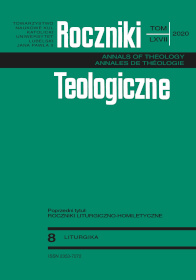Nałożenie rąk w liturgii święceń w pierwszym tysiącleciu (Część II: Średniowiecze)
Laying on Hands in the Liturgy of Ordination in the First Millennium (Part Two: Middle Ages)
Author(s): Waldemar BartochaSubject(s): Christian Theology and Religion, Theology and Religion, Pastoral Theology
Published by: Towarzystwo Naukowe KUL & Katolicki Uniwersytet Lubelski Jana Pawła II
Keywords: laying on hands; ordination; Holy Spirit; bishop; presbyter; deacon
Summary/Abstract: The aim of this article is to show the origin and theological meaning of the gesture of laying on hands, as well as its place in the structure of ordination celebrations in the first millennium. Referring to the history of the liturgy of ordination allows us to answer the question of how, in the Middle Ages, the gesture of placing hands was marginalized and obscured with new elements coming from different Western liturgies, such as anointing, handing over of robes or the ceremonial handing in of the insignia. The author uses liturgical sources (sacramentaries and Ordines Romani) and on their basis he follows the transformations in the structure of the liturgy of ordination. In the Roman liturgy until the 10th century, i.e. until the acceptance by Rome of the “Roman-Germanic Pontificate,” created in Mainz in 950, the gesture of laying on hands and the prayer of ordination constituted a specific core of the whole celebration of ordination. The analysis of the Ordines Romani also confirms the practice of using this liturgical gesture. However, here it is rarely mentioned explicitly. The absence of reference to this is indicative of the weakening of the ecclesiological meaning of the gesture of laying on of hands.
Journal: Roczniki Teologiczne
- Issue Year: 67/2020
- Issue No: 8
- Page Range: 5-24
- Page Count: 20
- Language: Polish

